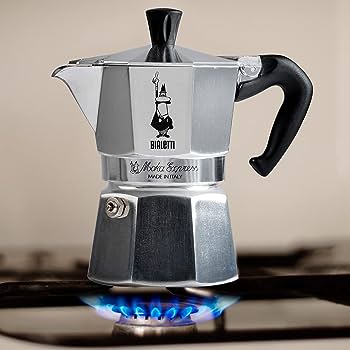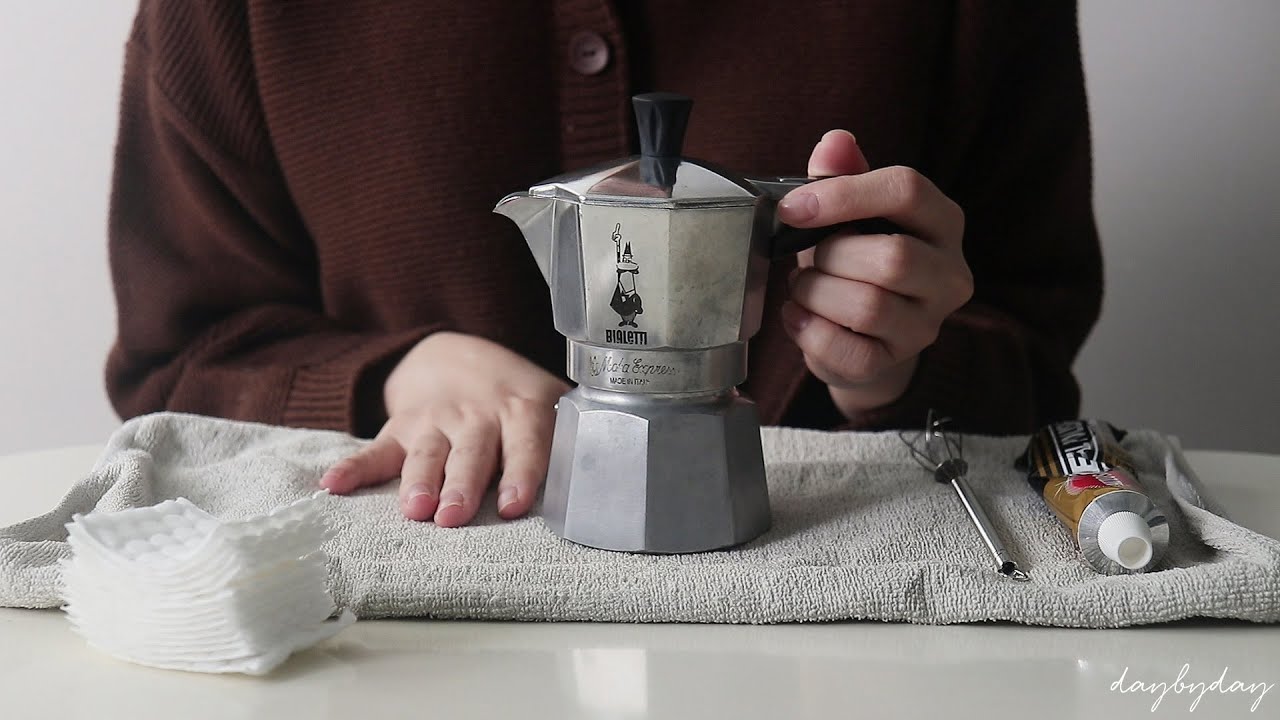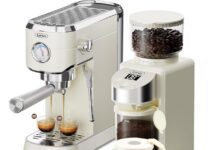So you’ve been enjoying your daily dose of Italian-style coffee with your trusty Bialetti Moka Pot. But lately, you’ve noticed that its once shiny exterior has lost its luster, leaving you wondering how to bring back that sparkling charm. Well, fear not, because we’ve got the solution for you. In this article, we’ll share some handy tips and tricks on how to make your Bialetti shiny again, so you can enjoy your coffee in style.
This image is property of i.ytimg.com.
Cleaning the Bialetti Exterior
Removing Stains with Vinegar
When it comes to cleaning the exterior of your Bialetti, vinegar can be a lifesaver. Simply dilute some vinegar with water and use a soft cloth or sponge to gently scrub away any stains or residue. The acidity of the vinegar helps to break down the stains and restore the shine to your Bialetti. Be sure to rinse thoroughly afterwards to remove any vinegar smell.
Polishing with Lemon and Salt
If your Bialetti has some stubborn stains that don’t seem to come off with vinegar alone, you can try using a mixture of lemon juice and salt. Sprinkle salt onto a lemon half and gently rub it onto the stains. The natural acidity of the lemon combined with the abrasive action of the salt helps to remove the stains and bring back the shine to your Bialetti. Make sure to rinse thoroughly afterwards to remove any lemon residue.
Using Baking Soda Paste
Another effective method for cleaning the exterior of your Bialetti is by using a baking soda paste. Simply mix baking soda with water to create a thick paste-like consistency. Apply the paste onto a soft cloth or sponge and gently scrub the exterior of your Bialetti. The baking soda acts as a mild abrasive, helping to remove stains and restore the shine. Rinse thoroughly afterwards to remove any residue.
Using Stainless Steel Cleaner
For a quick and easy way to clean and polish the exterior of your Bialetti, you can use a stainless steel cleaner. These cleaners are specifically designed to remove stains and restore the shine to stainless steel surfaces. Follow the instructions on the cleaner and use a soft cloth or sponge to gently clean and polish your Bialetti. This method is great for a quick touch-up or for regular maintenance.
Cleaning the Bialetti Interior
Cleaning with Dish Soap
To clean the interior of your Bialetti, start by disassembling the coffee maker. Wash all the removable parts, including the water reservoir and the filter basket, with warm water and dish soap. Use a sponge or brush to scrub away any coffee residue. Rinse thoroughly to ensure there is no soap residue left.
Removing Coffee Residue with Baking Soda
If you notice stubborn coffee residue on the interior of your Bialetti, you can use baking soda to remove it. Mix baking soda with water to create a paste and apply it to the interior surfaces. Use a sponge or brush to scrub the paste onto the residue and let it sit for a few minutes. Then, rinse thoroughly to remove the baking soda and residue.
Using Vinegar Solution
For a deep clean of the interior of your Bialetti, you can use a vinegar solution. Fill the water reservoir with equal parts water and vinegar and let it sit for about 30 minutes. Then, run a brewing cycle without coffee grounds to flush out the vinegar solution. This helps to remove any build-up and leave your Bialetti clean and fresh.
Cleaning the Handle and Lid
Using Dish Soap and Warm Water
To clean the handle and lid of your Bialetti, start by removing them if possible. Wash them with warm water and dish soap, using a sponge or brush to scrub away any stains or residue. Rinse thoroughly and dry with a soft cloth.
Removing Stains with Lemon
If the handle or lid of your Bialetti has stubborn stains, you can use a lemon to help remove them. Cut a lemon in half and rub it onto the stained areas. The natural acidity of the lemon can help break down the stains and restore the shine. Rinse thoroughly afterwards to remove any lemon residue.
Polishing with Olive Oil
To give the handle and lid of your Bialetti a nice shine, you can use olive oil. Apply a small amount of olive oil onto a soft cloth and gently polish the handle and lid. The olive oil helps to nourish and protect the surfaces, leaving them looking shiny and renewed.
Removing Mineral Deposits
Using Vinegar Solution
If you notice mineral deposits or limescale build-up in your Bialetti, you can use a vinegar solution to remove them. Fill the water reservoir with equal parts water and vinegar and let it sit for about 30 minutes. Then, run a brewing cycle without coffee grounds to flush out the vinegar solution. This helps to dissolve and remove the mineral deposits, leaving your Bialetti clean and functioning properly.
Using Lemon Juice
If you prefer a natural alternative to vinegar, you can use lemon juice to remove mineral deposits. Squeeze the juice of a lemon into the water reservoir and let it sit for about 30 minutes. Then, run a brewing cycle without coffee grounds to flush out the lemon juice. The acidity of the lemon juice helps to dissolve the mineral deposits, leaving your Bialetti clean and free from build-up.
This image is property of i.ytimg.com.
Preventing Future Stains
Rinsing Thoroughly after Use
One of the best ways to prevent stains on your Bialetti is to rinse it thoroughly after each use. This helps to remove any coffee residue or oils that can cause stains over time. Simply rinse the interior and exterior parts with warm water and gently scrub if needed. This quick step can go a long way in keeping your Bialetti looking shiny and clean.
Drying Completely
After washing or rinsing your Bialetti, it is important to dry it completely before storing it. Moisture can lead to stains and even rust over time. Use a soft cloth or towel to dry all the parts thoroughly, including the handle and lid. Take extra care to dry any hard-to-reach areas to ensure there is no moisture left.
Avoiding Harsh Scrubbing
While it might be tempting to use abrasive materials or harsh scrubbing to remove tough stains, it is important to avoid these methods as they can damage the finish of your Bialetti. Stick to gentle cleaning techniques and use soft cloths or sponges to avoid scratching or dulling the surface. This will help to maintain the overall appearance of your Bialetti.
Storing the Bialetti
Keeping in a Dry Place
When it comes to storing your Bialetti, it is important to keep it in a dry place. Moisture can lead to stains, rust, and even mold growth. Choose a cool and dry location, away from any sources of moisture, such as sinks or windows. This will help to preserve the condition of your Bialetti and prevent any unwanted damage.
Using a Protective Cover
If you want to take extra precautions to protect your Bialetti while it is in storage, you can use a protective cover. This can be a cloth bag or a specially designed cover for coffee makers. The cover helps to shield your Bialetti from dust, dirt, and any potential scratches. It is a simple yet effective way to keep your Bialetti in great condition when not in use.
Avoiding Excessive Moisture
In addition to storing your Bialetti in a dry place, it is important to avoid excessive moisture in its vicinity. This means keeping it away from areas with high humidity, such as bathrooms or near stovetops. Moisture in the air can still affect the condition of your Bialetti even if it is not directly exposed to water. By being mindful of the environment in which you store your Bialetti, you can help to prolong its lifespan.
This image is property of 3.bp.blogspot.com.
Troubleshooting Tips
Dealing with Stubborn Stains
If you come across stubborn stains that seem impossible to remove, you can try a few additional methods. One option is to soak the affected parts in a solution of warm water and dish soap for an extended period of time, then scrub gently with a soft brush. Another option is to use a non-abrasive cleaning product specifically designed for coffee makers. These products can be found in stores or online and can help to tackle tough stains without damaging your Bialetti.
Handling Rust Spots
If you notice rust spots on your Bialetti, it is important to address them promptly to prevent further damage. Start by gently scrubbing the rust spots with a soft brush or sponge and warm water. If the rust persists, you can try using a mixture of baking soda and water to create a paste and apply it to the rust spots. Let it sit for a few minutes and then scrub gently. Rinse thoroughly afterwards and dry completely to prevent the rust from reoccurring.
Addressing Discoloration
Over time, you may notice some discoloration on the interior or exterior of your Bialetti. This can be caused by factors such as coffee oils, mineral deposits, or exposure to heat. To address discoloration, you can use a vinegar solution or lemon juice to soak the affected parts for about 30 minutes. Then, scrub gently with a soft brush or sponge. Rinse thoroughly and dry completely to restore the original shine and color of your Bialetti.
Maintaining the Bialetti
Regular Cleaning Routine
To keep your Bialetti in great condition, it is important to establish a regular cleaning routine. This includes cleaning the exterior and interior parts after each use, as well as performing deep cleans periodically. By incorporating regular cleaning into your coffee-making routine, you can prevent stains and build-up from becoming a problem.
Avoiding Abrasive Cleaners
One common mistake to avoid when cleaning your Bialetti is using abrasive cleaners. These cleaners can scratch or dull the finish of your coffee maker, ruining its appearance. Instead, opt for gentle cleaning methods and use non-abrasive materials, such as soft cloths or sponges. This will help to maintain the shine and overall condition of your Bialetti.
Checking for Damage
Regularly inspect your Bialetti for any signs of damage. This includes cracks, dents, or loose parts. If you notice any damage, it is important to address it promptly to prevent further issues. Depending on the severity of the damage, you may need to replace certain parts or even consider getting a new Bialetti. Regularly checking for damage ensures that your coffee maker continues to function properly and lasts for a long time.
This image is property of www.bialetti.com.
Common Mistakes to Avoid
Using Harsh Chemicals
One of the most common mistakes to avoid when cleaning your Bialetti is using harsh chemicals. These chemicals can damage the finish and even contaminate your coffee. Stick to natural cleaning agents, such as vinegar, lemon, or baking soda, to ensure the safety and longevity of your Bialetti. It is always better to opt for gentle and eco-friendly methods of cleaning.
Neglecting Regular Cleaning
Another mistake to avoid is neglecting regular cleaning. It can be tempting to skip a cleaning session here or there, especially when you’re in a rush. However, this can lead to a build-up of stains and residue that becomes harder to clean over time. By establishing a regular cleaning routine and sticking to it, you can avoid this problem and keep your Bialetti in excellent condition.
Scrubbing with Abrasive Materials
Using abrasive materials, such as steel wool or abrasive sponges, is a mistake to avoid when cleaning your Bialetti. These materials can scratch or damage the finish of your coffee maker, affecting its appearance and performance. Stick to soft cloths, sponges, or brushes that are specifically designed for gentle cleaning to prevent any unwanted damage.
Final Thoughts
With the proper cleaning and maintenance, your Bialetti can remain shiny and in great condition for years to come. By following the tips and techniques outlined in this article, you can easily remove stains, prevent future build-up, and address any issues that may arise. Remember to be gentle, use natural cleaning agents, and establish a regular cleaning routine for the best results. With a little effort, your Bialetti will continue to brew delicious coffee and bring joy to your mornings. Happy cleaning!
This image is property of Amazon.com.










































